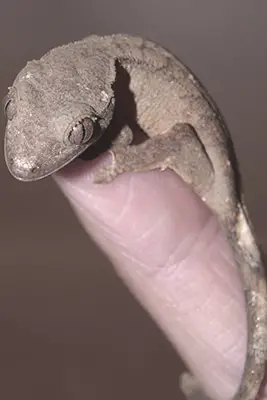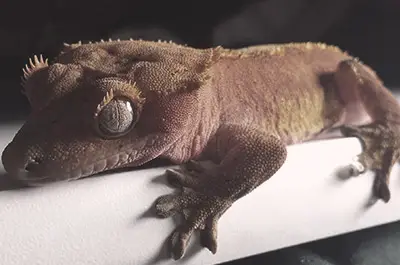When it comes to exotic pets, the crested gecko is undoubtedly one of the most popular choices. These little lizards are remarkably easy to care for, making them an ideal option for first-time reptile owners. In this guide, we will walk you through everything you need to know about caring for a crested gecko.
We have got you covered, from diet and habitat to health and handling! So, whether you are just considering adding a crested gecko to your family or are already a proud lizard parent, read on for some essential tips on how to care for your pet crested gecko.
Housing.

Although crested geckos are small lizards, they require a relatively large tank for their size. For a single adult, you will need at least a 20-gallon long tank – larger if housing multiple animals – with secure screen covers.
Crested geckos prefer to climb, so you will want to provide your lizards with plenty of branches and toys to aid in climbing.
Securing your crested gecko’s tank inside a reptile rack is ideal, not only because it keeps the tank up off the floor but also because it provides increased security for all animals contained within the rack.
Crested geckos are nocturnal, so you will want to keep the tank in a low-traffic area where your gecko can retreat into its hide during the day.
Feeding.
Crested geckos eat insects, making them easy pets for owners who don’t like dealing with live feeder rodents. The bulk of a crested gecko’s diet comes from appropriately sized crickets, which you can purchase at your local pet store. A few other insects, such as waxworms and mealworms, may be offered to your lizard in small numbers.
Insects should make up 80% of your crested gecko’s diet; fruit and vegetables should only be included in the diet as a tiny, occasional treat. Crested geckos cannot process plant matter well and can develop serious health problems if fed too many greens.
Dust all insects in your crested gecko’s diet with a high-quality calcium supplement. This will ensure that your gecko gets all of the calcium it needs to maintain strong bones and healthy growth.
Watering.
Crested geckos require a dish of fresh water that you will need to change daily. Not only will your crested gecko drink from this dish, but it will also use water to aid in shedding its skin.
This is particularly important for crested geckos living in humid environments. They can quickly develop retained skin, which will not come off after shedding and can lead to dangerous infections if not removed.
The drinking water dish should be shallow and should be changed at least once a day. Crested geckos do not typically drink from standing water, so your pet will lap up the droplets of water that accumulate in the dish throughout the day.
Cleaning.

Crested geckos are relatively easy to care for, and their tanks can be spot cleaned between feedings. If you want to provide your gecko with a more naturalistic environment, you can purchase pine or fir shavings at your local pet store to line the bottom of the tank.
Spot-clean your crested gecko’s tank every few days. Remove any uneaten insects and give the tank a quick rinse with hot water before replacing your gecko’s substrate.
If you notice your crested gecko straining to poop or passing only minimal amounts of fecal matter, it may be time for a complete tank cleaning.
Remove your crested gecko and all items from the tank, disinfect with a reptile-safe disinfectant (do not use household cleaners like bleach or Lysol), rinse the entire tank with hot water, and allow it to air dry completely before placing your gecko back inside.
The tank should be completely dry before your crested gecko is allowed back inside.
Hands-Off!
Unlike some lizards, crested geckos do not enjoy being handled. Your pet may attempt to run or climb away from you, which can result in falling or other injuries. To prevent this, make sure your crested gecko is permanently housed in a secure enclosure.
It’s also important to know that crested geckos are very fragile. The tail, in particular, is prone to breaking, so you should only handle your crested gecko with clean hands.
Basking.
Crested geckos are cold-blooded, which means they rely on external sources to maintain their body temperature.
Crested geckos need to thermoregulate, which means that they must regulate their body temperature. To do so, crested geckos bask in the sun to warm up and cool down.
Place a small ceramic heat emitter over one end of the crested gecko’s tank to provide a basking spot that reaches between 85 and 95 degrees Fahrenheit.
A small, low-wattage night-time heat emitter should also be used to provide a slightly cooler retreat inside the crested gecko’s enclosure, which should reach about 65 degrees Fahrenheit.
Use a reliable digital thermometer to monitor the temperature of the enclosure.
Crested geckos cannot produce Vitamin D3 in their bodies and must get it from external sources. This is why crested geckos require ultraviolet B (UVB) light exposure. UVB is a type of ultraviolet light emitted from the sun and can be found in special bulbs sold in pet stores.
The special crested gecko bulbs sold in pet stores produce the UVB that your crested gecko needs to stay healthy, but be sure to buy the correct type of bulb. Many bulbs sold as reptile light emit UVA and UVB, but crested geckos require only UVB light.
UVB bulbs should be placed over the basking spot inside your pet’s tank for at least 12 hours a day. You can safely leave the light on for more extended periods as long as you provide a night-time retreat that is cooler and without UVB.
Leaving Geckos Alone!
Crested geckos are very shy animals, so leaving them alone in their tank is the best way to ensure they don’t get stressed from being handled too often. By purchasing your crested gecko from a reputable breeder, you can be sure that your lizard will have already been handled for a long time, meaning it will likely be very docile.
Crested geckos are nocturnal, so they aren’t active during the day, anyway. You can leave your crested gecko alone for up to 4-6 hours without feeding them, though you should check in on them at least once a day to ensure they are alright.
Skincare and shedding.

Crested geckos shed their skin as they grow. Shedding can happen several times a year and is usually preceded by cloudy eyes and a lack of appetite.
Your crested gecko may have difficulty shedding its skin if it has an inadequate hiding spot, so you should make sure your pet has somewhere to go when it feels like shedding.
Before they shed their skin, crested geckos will become very sluggish and refuse to eat. This is perfectly normal, and your crested gecko will be back to its regular self as soon as it has shed and eaten.
Crested geckos shed their skin in pieces, which can make it hard to tell when your pet is about to molt. If you notice your crested gecko’s eyes seem to be sunken in, the gecko is likely about to shed.
If you want to make sure your gecko’s skin does not get stuck and tear off, rub a little cornstarch onto its skin, which will act as an exfoliant.
Spot-clean your crested gecko’s enclosure between feedings, and remove any uneaten food items.
Crested geckos should never receive direct sunlight or be left out in the open for a long time.
Direct sunlight and drafts will cause your crested gecko to dehydrate and become sick. If you choose to use a screen lid on your crested geckos’ tank, make sure it is always propped slightly open so that fresh air can get in.
Heat lamps and ceramic heat emitters should be used sparingly, as crested geckos cannot tolerate high temperatures. If your crested gecko is in an excessively hot environment, it may stop eating.
You should only handle your crested gecko with clean hands.
This will keep you from spreading any harmful bacteria. If you must manipulate your crested gecko, do so gently and avoid placing your pet’s tail under stress. If you drop or mishandle your pet, hold your crested gecko away from you, as they may accidentally scratch or bite.
Crested geckos should only be handled when necessary, and handling should always be kept to a minimum. Harmful bacteria are likely to give your crested gecko problems, including significant weight loss. They have Harmful bacteria, too, so you need to wash your hands after handling them.
Do not handle your crested gecko for about a week after it has shed its skin. Handling the lizard too soon can cause the already-shed skin to tear.
Handling your crested gecko too soon after it has shed its skin will also cause the skin to dry out, peel off early and potentially get stuck to other parts of your gecko’s body.
Crested geckos are notorious for dropping their tails when they feel threatened. When your crested gecko drops its tail, it will regenerate quickly, and you can expect to see a new one appear in just one or two sheds.
Conclusion.
If you’re looking for an engaging, low-maintenance pet to add to your home, a crested gecko may be a perfect choice. These lizards are gentle and can be handled easily, making them ideal for beginning reptile owners. With the proper care, they can live long and healthy lives. So if you’re thinking of adding a new addition to your family, consider a crested gecko!

Dive into the insights of Matthew Mansour, a seasoned life coach, fitness guru, and health mentor. With a portfolio boasting over 800 thought-provoking articles, Matthew is passionate about unraveling the intricate layers of the human psyche. His reading choices? Books that shed light on our unique human journey, helping him (and his readers) harness the power of the mind, transforming challenges into stepping stones.
Matthew proudly wears his badge as a self-help aficionado. His mantra? There’s always room to grow, learn, and be inspired. He thrives on gleaning wisdom from pioneers, turning their experiences into valuable lessons for all.
Always on the pulse of emerging trends, Matthew immerses himself in groundbreaking courses and research centered around life coaching and holistic health. Eager to impart his knowledge, he’s here to guide anyone keen on enhancing their life journey.
Beyond his professional persona, Matthew is a devoted animal lover, a proud New Jersey resident, and a doting husband and father. Dive into his self-improvement blog and let Matthew guide you towards a life filled with purpose and passion!
Reviewed By: Joanna Perez and Marcella Raskin
Edited By: Lenny Terra
Fact Checked By: Gabrielle J. Smith
Photos Taken or Curated By: Matthew Mansour